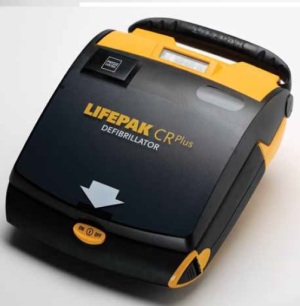by
Lisa Chamoff, Contributing Reporter | May 12, 2014

LIFEPAK CRPlus image
courtesy of Physio-Control
From the May 2014 issue of HealthCare Business News magazine
A year ago, manufacturers of automated external defibrillators and groups that promote use of the life-saving equipment in schools, fitness centers and other public facilities asked the U.S. Food and Drug Administration to reconsider a controversial proposal to make the process for getting the devices on the market more stringent — and as a consequence more costly — after a number of malfunctions and recalls.
While the proposed order has not yet been finalized, some companies are preparing for when — not if — the new regulations will take effect.
In March 2013, the FDA released a proposed order to require the filing of a premarket approval application (PMA) or a notice of completion of a product development protocol (PDP) for AEDs. While AEDs are technically already considered Class III devices, the highest-risk category, which typically requires a PMA, they were on the market before 1976, when the initial medical device amendments were passed. As such, they are currently classified as preamendment devices and are one of the few Class III devices permitted to come to market through the less stringent 510(k) application process.
Susan Laine, an FDA spokeswoman, says the agency cannot speculate on when the order will be finalized.
“We collected public comments on the proposed order and all are considered as the FDA drafts the final order,” Laine says.
Share your comments
By the end of June, the FDA received dozens of comments from manufacturers, industry groups and medical professionals, most warning that the proposed order would stifle innovation and increase the cost of AEDs, curtailing the hoped-for widespread adoption of the devices, which can help prevent death from sudden cardiac arrest.
Sudden cardiac arrest is usually caused by ventricular fibrillation, an abnormal heart rhythm that causes the heart to stop pumping blood. AEDs use a computer to monitor the victim’s heart rhythm and either administer a shock or direct the AED user to administer one.
AEDs, which came on the market in the mid-1990s, can today be found in many public places, including schools, airports, malls and workplaces. According to the Sudden Cardiac Arrest Foundation, about 360,000 people in the U.S. experience SCA outside of a hospital and about 90 percent of them die. The devices cost between $1,000 and $2,500.
“As it is now, it’s difficult for a lot of community groups to get access to the devices,” says Mary Newman, the head of the Sudden Cardiac Arrest Foundation, which is sponsored by AED manufacturers. “We hear from people every day — schools, places of worship — that are trying to acquire an AED and they don’t have the budget for it. I imagine if these regulations do increase it will make it that much more difficult for community organizations to acquire those devices. At some point the price will be passed along to the consumer.”
